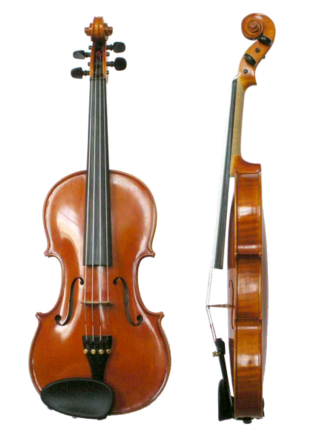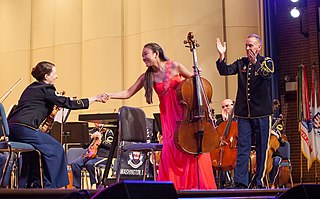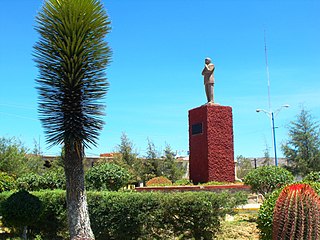Related Research Articles

The double bass, also known as the upright bass, the acoustic bass, the bull fiddle, or simply the bass, is the largest and lowest-pitched chordophone in the modern symphony orchestra. It has four or five strings, and its construction is in between that of the gamba and the violin family.

An orchestra is a large instrumental ensemble typical of classical music, which combines instruments from different families. There are typically four main sections of instruments:

The violin, sometimes referred as a fiddle, is a wooden chordophone, and is the smallest, and thus highest-pitched instrument (soprano) in regular use in the violin family. Smaller violin-type instruments exist, including the violino piccolo and the pochette, but these are virtually unused. Most violins have a hollow wooden body, and commonly have four strings, usually tuned in perfect fifths with notes G3, D4, A4, E5, and are most commonly played by drawing a bow across the strings. The violin can also be played by plucking the strings with the fingers (pizzicato) and, in specialized cases, by striking the strings with the wooden side of the bow.

In musical instrument classification, string instruments, or chordophones, are musical instruments that produce sound from vibrating strings when a performer strums, plucks, strikes or sounds the strings in varying manners.

Pizzicato is a playing technique that involves plucking the strings of a string instrument. The exact technique varies somewhat depending on the type of instrument:

One Hundred Men and a Girl is a 1937 American musical comedy film directed by Henry Koster and starring Deanna Durbin and the maestro Leopold Stokowski. Written by Charles Kenyon, Bruce Manning, and James Mulhauser from a story by Hanns Kräly, the film is about the daughter of a struggling musician who forms a symphony orchestra consisting of his unemployed friends. Through persistence, charm, and a few misunderstandings, they are able to get famed conductor Leopold Stokowski to lead them in a concert, which leads to a radio contract. One Hundred Men and a Girl was the first of two motion pictures featuring Leopold Stokowski, and is also one of the films for which Durbin is best remembered as an actress and a singer.

The NBC Symphony Orchestra was a radio orchestra conceived by David Sarnoff, the president of the Radio Corporation of America, the parent corporation of the National Broadcasting Company especially for the conductor Arturo Toscanini. The NBC Symphony Orchestra performed weekly radio broadcast concerts with Toscanini and other conductors and several of its players served in the house orchestra for the NBC Radio Network. NBC encouraged the public’s perception of the Orchestra as a full-time organization exclusively at Toscanini’s beck and call, but Fortune disclosed in 1938 that these instrumentalists played other radio—and, later, television—broadcasts: “the Toscanini concerts have been allocated only fifteen of the thirty hours a week each man works, including rehearsals.”

Arturo Toscanini was an Italian conductor. He was one of the most acclaimed and influential musicians of the late 19th and early 20th century, renowned for his intensity, his perfectionism, his ear for orchestral detail and sonority, and his eidetic memory. He was at various times the music director of La Scala in Milan and the New York Philharmonic. Later in his career, he was appointed the first music director of the NBC Symphony Orchestra (1937–1954), and this led to his becoming a household name, especially in the United States, through his radio and television broadcasts and many recordings of the operatic and symphonic repertoire.

The Philadelphia Orchestra is an American symphony orchestra, based in Philadelphia. One of the "Big Five" American orchestras, the orchestra is based at the Kimmel Center for the Performing Arts, where it performs its subscription concerts, numbering over 130 annually, at Marian Anderson Hall.

Leopold Anthony Stokowski was a British-born American conductor. One of the leading conductors of the early and mid-20th century, he is best known for his long association with the Philadelphia Orchestra. He was especially noted for his free-hand conducting style that spurned the traditional baton and for obtaining a characteristically sumptuous sound from the orchestras he directed.

Conducting is the art of directing a musical performance, such as an orchestral or choral concert. It has been defined as "the art of directing the simultaneous performance of several players or singers by the use of gesture." The primary duties of the conductor are to interpret the score in a way that reflects the specific indications in that score, set the tempo, ensure correct entries by ensemble members, and "shape" the phrasing where appropriate. Conductors communicate with their musicians primarily through hand gestures, usually with the aid of a baton, and may use other gestures or signals such as facial expression and eye contact. A conductor usually supplements their direction with verbal instructions to their musicians in rehearsal.

The concertmaster, first chair (U.S.) or leader (U.K.) is the principal first violin player in an orchestra. After the conductor, the concertmaster is the most significant leader in an orchestra, symphonic band or other musical ensemble.

Julián Carrillo Trujillo was a Mexican composer, conductor, violinist and music theorist, famous for developing a theory of microtonal music which he dubbed "The Thirteenth Sound".

A rehearsal is an activity in the performing arts that occurs as preparation for a performance in music, theatre, dance and related arts, such as opera, musical theatre and film production. It is undertaken as a form of practising, to ensure that all details of the subsequent performance are adequately prepared and coordinated. The term rehearsal typically refers to ensemble activities undertaken by a group of people. For example, when a musician is preparing a piano concerto in their music studio, this is called practising, but when they practice it with an orchestra, this is called a rehearsal. The music rehearsal takes place in a music rehearsal space.

Leopold Stokowski's orchestration of Pictures at an Exhibition by Modest Mussorgsky was completed in 1939 and premiered later that year, on 17 November, by the Philadelphia Orchestra.

Playing the violin entails holding the instrument between the jaw and the collar bone. The strings are sounded either by drawing the bow across them (arco), or by plucking them (pizzicato). The left hand regulates the sounding length of the strings by stopping them against the fingerboard with the fingers, producing different pitches.
The Hollywood String Quartet (HSQ) was an American string quartet founded by violinist/conductor Felix Slatkin and his wife cellist Eleanor Aller. The Hollywood String Quartet is considered to be the first American-born and trained classical music chamber group to make an international impact, mainly through its landmark recordings. These recordings have long been regarded as among the most outstanding recorded performances of the string quartet repertoire.
Bells for Stokowski for Orchestra and for Symphonic Band by American composer Michael Daugherty, is a 14-minute, single-movement tribute to one of the most prominent 20th century conductors, Leopold Stokowski. Bells for Stokowski for Orchestra (2001) stands alone as a concert piece, however, it is also the last movement of the three-movement work, Philadelphia Stories. Philadelphia Stories was commissioned by the Philadelphia Orchestra in celebration of the Orchestra's centennial under the direction of Wolfgang Sawallisch. The premiere was performed by the Philadelphia Orchestra at the Academy of Music in Philadelphia, under the direction of David Zinman, in November 2001.

The string section of an orchestra is composed of bowed instruments belonging to the violin family. It normally consists of first and second violins, violas, cellos, and double basses. It is the most numerous group in the standard orchestra. In discussions of the instrumentation of a musical work, the phrase "the strings" or "and strings" is used to indicate a string section as just defined. An orchestra consisting solely of a string section is called a string orchestra. Smaller string sections are sometimes used in jazz, pop, and rock music and in the pit orchestras of musical theatre.

Ludwig Paul Maria "Luigi" von Kunits was a Canadian conductor, composer, violinist, and pedagogue. Born in Austria, he studied at the Vienna Conservatory. He later moved to Canada where he was the founding conductor of the Toronto Symphony Orchestra in 1922.
References
- ↑ Pogue, David; Speck, Scott (2015-06-25). Classical Music For Dummies. John Wiley & Sons. ISBN 9781119049746.
- ↑ Smith, William Ander (1990-01-01). The Mystery of Leopold Stokowski. Fairleigh Dickinson Univ Press. ISBN 9780838633625.
- ↑ "Explore Your Bow for a Uniform Orchestral Sound". Archived from the original on 2005-12-28. Retrieved 2006-02-14.
- ↑ Video on YouTube, performance of "Inta Omri" with Umm Kulthum
- ↑ "Bells for Stokowski | Cabrillo Festival of Contemporary Music". www.cabrillomusic.org. Archived from the original on May 9, 2005.